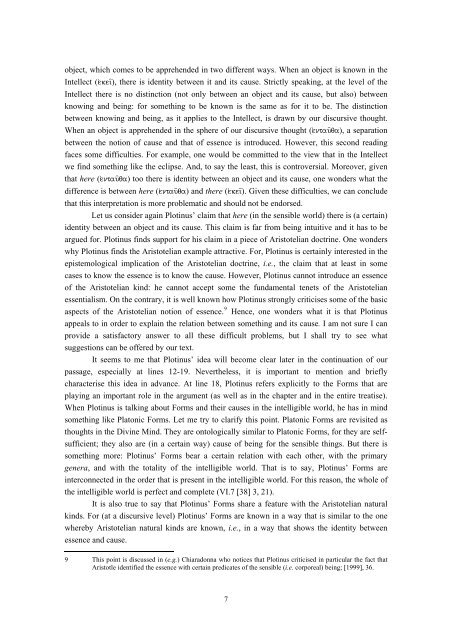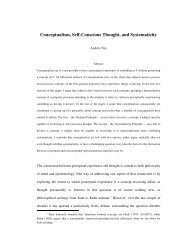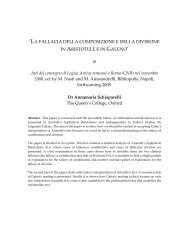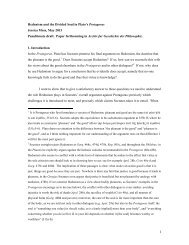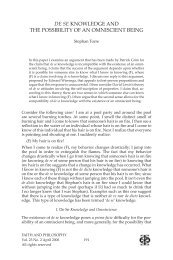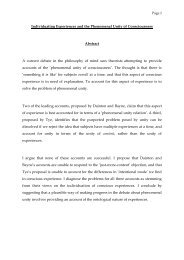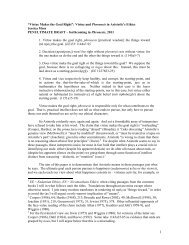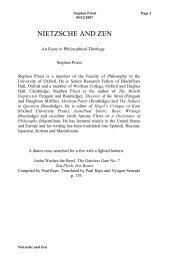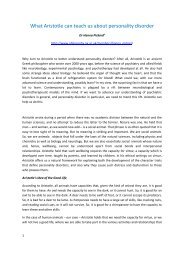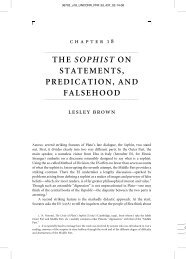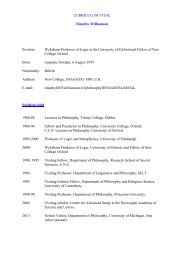Essence and Cause in Plotinus
Essence and Cause in Plotinus
Essence and Cause in Plotinus
You also want an ePaper? Increase the reach of your titles
YUMPU automatically turns print PDFs into web optimized ePapers that Google loves.
object, which comes to be apprehended <strong>in</strong> two different ways. When an object is known <strong>in</strong> the<br />
Intellect (e)keiÍ), there is identity between it <strong>and</strong> its cause. Strictly speak<strong>in</strong>g, at the level of the<br />
Intellect there is no dist<strong>in</strong>ction (not only between an object <strong>and</strong> its cause, but also) between<br />
know<strong>in</strong>g <strong>and</strong> be<strong>in</strong>g: for someth<strong>in</strong>g to be known is the same as for it to be. The dist<strong>in</strong>ction<br />
between know<strong>in</strong>g <strong>and</strong> be<strong>in</strong>g, as it applies to the Intellect, is drawn by our discursive thought.<br />
When an object is apprehended <strong>in</strong> the sphere of our discursive thought (e)ntau=qa), a separation<br />
between the notion of cause <strong>and</strong> that of essence is <strong>in</strong>troduced. However, this second read<strong>in</strong>g<br />
faces some difficulties. For example, one would be committed to the view that <strong>in</strong> the Intellect<br />
we f<strong>in</strong>d someth<strong>in</strong>g like the eclipse. And, to say the least, this is controversial. Moreover, given<br />
that here (e)ntau=qa) too there is identity between an object <strong>and</strong> its cause, one wonders what the<br />
difference is between here (e)ntau=qa) <strong>and</strong> there (e)keiÍ). Given these difficulties, we can conclude<br />
that this <strong>in</strong>terpretation is more problematic <strong>and</strong> should not be endorsed.<br />
Let us consider aga<strong>in</strong> Plot<strong>in</strong>us’ claim that here (<strong>in</strong> the sensible world) there is (a certa<strong>in</strong>)<br />
identity between an object <strong>and</strong> its cause. This claim is far from be<strong>in</strong>g <strong>in</strong>tuitive <strong>and</strong> it has to be<br />
argued for. Plot<strong>in</strong>us f<strong>in</strong>ds support for his claim <strong>in</strong> a piece of Aristotelian doctr<strong>in</strong>e. One wonders<br />
why Plot<strong>in</strong>us f<strong>in</strong>ds the Aristotelian example attractive. For, Plot<strong>in</strong>us is certa<strong>in</strong>ly <strong>in</strong>terested <strong>in</strong> the<br />
epistemological implication of the Aristotelian doctr<strong>in</strong>e, i.e., the claim that at least <strong>in</strong> some<br />
cases to know the essence is to know the cause. However, Plot<strong>in</strong>us cannot <strong>in</strong>troduce an essence<br />
of the Aristotelian k<strong>in</strong>d: he cannot accept some the fundamental tenets of the Aristotelian<br />
essentialism. On the contrary, it is well known how Plot<strong>in</strong>us strongly criticises some of the basic<br />
aspects of the Aristotelian notion of essence. 9 Hence, one wonders what it is that Plot<strong>in</strong>us<br />
appeals to <strong>in</strong> order to expla<strong>in</strong> the relation between someth<strong>in</strong>g <strong>and</strong> its cause. I am not sure I can<br />
provide a satisfactory answer to all these difficult problems, but I shall try to see what<br />
suggestions can be offered by our text.<br />
It seems to me that Plot<strong>in</strong>us’ idea will become clear later <strong>in</strong> the cont<strong>in</strong>uation of our<br />
passage, especially at l<strong>in</strong>es 12-19. Nevertheless, it is important to mention <strong>and</strong> briefly<br />
characterise this idea <strong>in</strong> advance. At l<strong>in</strong>e 18, Plot<strong>in</strong>us refers explicitly to the Forms that are<br />
play<strong>in</strong>g an important role <strong>in</strong> the argument (as well as <strong>in</strong> the chapter <strong>and</strong> <strong>in</strong> the entire treatise).<br />
When Plot<strong>in</strong>us is talk<strong>in</strong>g about Forms <strong>and</strong> their causes <strong>in</strong> the <strong>in</strong>telligible world, he has <strong>in</strong> m<strong>in</strong>d<br />
someth<strong>in</strong>g like Platonic Forms. Let me try to clarify this po<strong>in</strong>t. Platonic Forms are revisited as<br />
thoughts <strong>in</strong> the Div<strong>in</strong>e M<strong>in</strong>d. They are ontologically similar to Platonic Forms, for they are selfsufficient;<br />
they also are (<strong>in</strong> a certa<strong>in</strong> way) cause of be<strong>in</strong>g for the sensible th<strong>in</strong>gs. But there is<br />
someth<strong>in</strong>g more: Plot<strong>in</strong>us’ Forms bear a certa<strong>in</strong> relation with each other, with the primary<br />
genera, <strong>and</strong> with the totality of the <strong>in</strong>telligible world. That is to say, Plot<strong>in</strong>us’ Forms are<br />
<strong>in</strong>terconnected <strong>in</strong> the order that is present <strong>in</strong> the <strong>in</strong>telligible world. For this reason, the whole of<br />
the <strong>in</strong>telligible world is perfect <strong>and</strong> complete (VI.7 [38] 3, 21).<br />
It is also true to say that Plot<strong>in</strong>us’ Forms share a feature with the Aristotelian natural<br />
k<strong>in</strong>ds. For (at a discursive level) Plot<strong>in</strong>us’ Forms are known <strong>in</strong> a way that is similar to the one<br />
whereby Aristotelian natural k<strong>in</strong>ds are known, i.e., <strong>in</strong> a way that shows the identity between<br />
essence <strong>and</strong> cause.<br />
9 This po<strong>in</strong>t is discussed <strong>in</strong> (e.g.) Chiaradonna who notices that Plot<strong>in</strong>us criticised <strong>in</strong> particular the fact that<br />
Aristotle identified the essence with certa<strong>in</strong> predicates of the sensible (i.e. corporeal) be<strong>in</strong>g; [1999], 36.<br />
7


